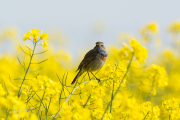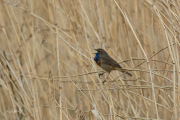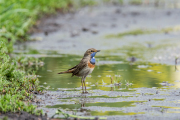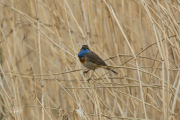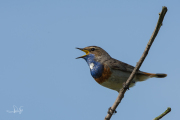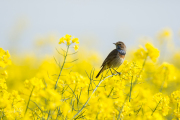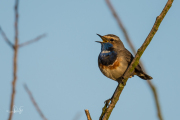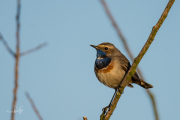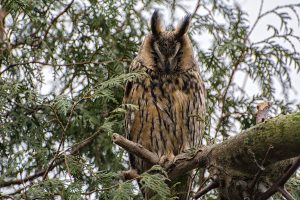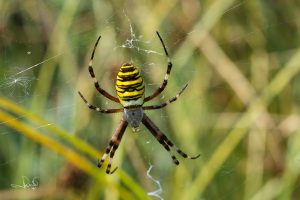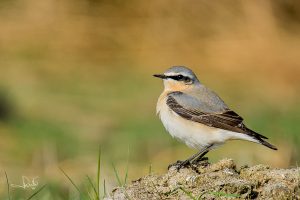Slowly but surely everything starts to turn green again, the trees are budding, the plants are awaking from their hibernation and the first migratory birds are arriving from Africa. Recently I walked our Frysian Staby Joes, when I suddenly caught a glimpse of a bird moving in the reeds. Although this little bird was hiding between the reeds I was still able to get good sight it: a bluethroat (Luscinia svecica cyanecula). They are back!
Nightingale
After the bluethroats return we don’t have to wait long before the males start singing their beautiful song, with their clear blue throat and chest. High in the reeds they do their utmost to impress the females. This is how it works in the world of birds, the males who can sing in the most beautiful and powerful way get the females first. After all, powerful singing implies a powerful male and thus healthy offspring.
There’s a reason why this bird belongs to the same genus as the nightingale (Luscinia megarhynchos). Apart from the fact that both species are closely related, both speciesproduce a powerful and beautiful sound. The specific name svecicameans “from Sweden”. Linnaeus gave the bird this name in 1758. Perhaps the species was then very common in Sweden and therefore received this name.
Common species
You have a good chance to encounter a bluethroat in spring and summer. In the past this was different, between about 1900 and 1970 it was a species that in the Netherlands gradually decreased in number due to the disappearance of its habitat through drainage and argicultural intensification. In the 1970’sthere was a turning point due to the emergence of rugged marshy nature reserves, such as in the province of Flevoland. But also in the river area the bluethroat was given space by projects in the context of Room for the River. It went so well with the species that it was removed from the Red List. The number of breeding pairs in the Netherlands was estimated at approximately 10 000 around 2000.
White-spotted or red-spotted
You can see two variaties of the bluethroat in the Netherlands: the white-spotted (Luscinia svecica cyanecula) and the red-spotted variety (Luscinia svecica svecica). The first is the most common subspecies in our country. The beautiful blue chest is decorated with a white spot. The red-spotted is a very rare subspecies in the Netherlands, but in northern Scandinavia and the northern part of Asia all the way to Alaska, this subspecies is the most common one. Occasionally one wanders off to the Netherlands, like in 2015 in Blijham in the province or Groningen. In my younger years I have seen a red-spotted bluethroat in Canisvliet near my birthplace of Westdorpe in the southwest of the Netherlands. At that time we did not yet have a website such as observation.org to track our observations or Dutch Bird Alerts via pagers or telephones. And we had never heard of twitching at all. In my case, I reported my observations to my local birdwatching organisation: De Steltkluut. Because that’s how it went at that time.
Pay attention
So if you walk along a reed bed, have a good look and listen. You will have a good chance of seeing this beautiful bird scurrying around or perched at the top of a reed plume doing its utmost best to sing as well as it can. Stop for a moment and enjoy it. It is worth it.
This article was originally published in Dutch on March 19th 2017



